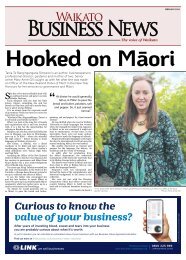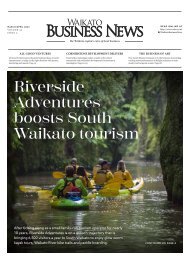Waikato Business News July/August 2023
Waikato Business News has for a quarter of a century been the voice of the region’s business community, a business community with a very real commitment to innovation and an ethos of cooperation.
Waikato Business News has for a quarter of a century been the voice of the region’s business community, a business community with a very real commitment to innovation and an ethos of cooperation.
Create successful ePaper yourself
Turn your PDF publications into a flip-book with our unique Google optimized e-Paper software.
6 WAIKATO BUSINESS NEWS, JULY/AUGUST <strong>2023</strong><br />
Haere rā Covid<br />
In <strong>August</strong> 2021, as New Zealand moved into yet another<br />
Covid-19 Alert Level 4 lockdown, the future of tourism in our<br />
region looked decidedly uncertain. But two years later things<br />
are very different – our international borders have fully reopened<br />
and we’ve seen the removal of the last of our country’s<br />
Covid-19 restrictions, signalling a return to normal life.<br />
In the time since international<br />
borders fully reopened<br />
to most travellers at 11.59pm<br />
on 31 <strong>July</strong> 2022, tourism in<br />
<strong>Waikato</strong> has recovered at an<br />
impressive pace.<br />
Earlier this year, we celebrated<br />
our first summer season<br />
with international visitors since<br />
early 2020. Despite challenges<br />
with staffing and severe weather<br />
events that could have derailed<br />
the summer, our tourism operators<br />
reported a good season.<br />
Conferencing has been<br />
strong over the past 12 months<br />
and looks set to continue, with<br />
events like the trans-Tasman<br />
AuSAE LINC conference and<br />
the New Zealand aquatic industry’s<br />
WAVES conference set<br />
to bring hundreds of business<br />
travellers to the region in September.<br />
The incentives market<br />
is also performing well, with<br />
Amway – the world’s largest<br />
direct selling company – choosing<br />
New Zealand, including<br />
the <strong>Waikato</strong>, as the destination<br />
where it will send the top<br />
performing employees from<br />
its China offices as part of its<br />
incentive programme to motivate<br />
and reward them.<br />
Successful events like the<br />
World Rugby Sevens, international<br />
cricket fixtures, Fieldays,<br />
Balloons over <strong>Waikato</strong>,<br />
Matariki ki <strong>Waikato</strong> Festival<br />
and the NZ Darts Masters<br />
all add to our reputation<br />
as a vibrant city and region,<br />
attracting visitors and boosting<br />
the economy.<br />
Most recently we welcomed<br />
fans and teams from Zambia,<br />
Japan, Switzerland, Norway,<br />
Portugal, Vietnam, Costa Rica,<br />
Argentina and Sweden as part<br />
of the FIFA Women’s World<br />
Cup <strong>2023</strong>TM. This influx of visitors,<br />
at what is traditionally a<br />
quieter period for international<br />
visitors, has been another boon<br />
for the region.<br />
By the numbers, we’ve seen<br />
13.2 million visitor days to the<br />
region in the past year, with 88<br />
per cent of those domestic. Both<br />
domestic and international visitor<br />
spend is up on the previous<br />
12 months, by 18 per cent and<br />
225 per cent respectively. Hamilton<br />
City has the top overall<br />
TELLING<br />
WAIKATO’S STORY<br />
BY NICOLA GREENWELL<br />
Chief executive, Hamilton &<br />
<strong>Waikato</strong> Tourism<br />
commercial accommodation<br />
occupancy rate for the country<br />
at 75 per cent, with the rate for<br />
the region coming in three per<br />
cent above the national average<br />
of 57 per cent.<br />
While more work is needed,<br />
there has been some good news<br />
for those struggling to find<br />
staff, with Immigration New<br />
Zealand approving close to<br />
18,000 Accredited Employer<br />
Work Visas since May last year.<br />
Cooks and chefs are leading the<br />
charge into the country, representing<br />
almost 30 per cent of all<br />
approved visas.<br />
New Zealand has also seen<br />
more than 60,000 Working<br />
Holiday Visas approved since<br />
March last year, with an additional<br />
32,276 granted under<br />
special direction from the Minister<br />
of Immigration due to the<br />
impacts of being unable to enter<br />
New Zealand during the Covid-<br />
19 pandemic. Working Holiday<br />
Visas offer dual benefits for the<br />
tourism and hospitality sectors,<br />
by bringing people who are<br />
both visitors and workers into<br />
the country.<br />
Perhaps the most exciting<br />
news is that this all doesn’t look<br />
like slowing anytime soon. Our<br />
operators across the region are<br />
reporting strong interest and<br />
bookings for the upcoming September/October<br />
school holidays,<br />
and beyond into the <strong>2023</strong>-<br />
24 summer season.<br />
Our international markets<br />
are now all back on stream,<br />
with Australia and North America<br />
leading the way. This is supported<br />
by increasing air connectivity<br />
into New Zealand, with<br />
several more airlines announcing<br />
their return to New Zealand<br />
later this year.<br />
Ten airlines, including Air<br />
New Zealand, Qantas, United<br />
Airlines, Delta and American<br />
Airlines, are now offering flights<br />
between New Zealand and the<br />
United States or Canada and<br />
the next couple of months will<br />
see 46 per cent more capacity<br />
– 300,000 more seats –<br />
from North America than last<br />
summer, with some airlines<br />
offering more seats than before<br />
the pandemic.<br />
The Tourism Export Council<br />
of New Zealand (TECNZ)<br />
International Arrival Forecasts<br />
<strong>2023</strong>-2025 is forecasting a<br />
return of 80.4% pre-Covid total<br />
arrivals by year ending June<br />
2024 and 100% by year ending<br />
June 2025.<br />
As we move into this new<br />
era Tourism New Zealand and<br />
Regional Tourism Organisations<br />
(RTO’s) are focused on<br />
attracting high quality visitors<br />
– those that enrich our<br />
communities and create value<br />
more broadly for the benefit<br />
of our people, our place, and<br />
collective prosperity.<br />
The challenge for all of us<br />
is to be ready to leverage these<br />
opportunities – something I<br />
have no doubt we’re up for.<br />
Housing Affordability: are<br />
we solving the right problem?<br />
A<br />
number of conversations<br />
recently have<br />
led me to ask whether<br />
we are focusing our collective<br />
problem solving attention<br />
on the right part of the<br />
problem with regards to<br />
housing affordability.<br />
Last month I wrote about<br />
several new building technologies<br />
and speculated as to<br />
the potential of technology<br />
and automation to improve<br />
productivity in the construction<br />
sector. I’ve also previously<br />
touched on inefficiencies<br />
related to the often<br />
segmented, siloed work of<br />
different parties in property<br />
development and the need for<br />
a more joined up end-to-end<br />
development approach.<br />
However, while they may<br />
help to bring down building<br />
costs over time, neither of these<br />
are likely to result in immediate<br />
improvements in the cost of<br />
new housing of the magnitude<br />
required to make it ‘affordable’.<br />
And despite recent drops, and<br />
changes to tax settings, the<br />
price of existing housing stock<br />
remains high and continues to<br />
enjoy a significant advantage<br />
over other investment options<br />
for those who have existing<br />
LANDMARKS<br />
BY PHIL MACKAY<br />
Phil Mackay is <strong>Business</strong><br />
Devolpment Manger at<br />
Hamilton-based PAUA,<br />
Procuta Associates Urban +<br />
Architecture<br />
equity to leverage.<br />
Some councils are testing<br />
the idea of measures that<br />
would require developers to<br />
include a certain percentage<br />
of ‘affordable’ houses in new<br />
developments. While well-intentioned,<br />
I’m sceptical as to<br />
whether this would result in<br />
desirable outcomes. In the<br />
best case scenario such measures<br />
would only solve the<br />
affordability problem for the<br />
first purchaser, thereafter the<br />
market would again dictate<br />
the price.<br />
Organisations such as<br />
Bridge Housing are implementing<br />
innovative models to<br />
make home ownership available<br />
to those on more modest<br />
incomes, while others are<br />
exploring co-housing concepts<br />
and Māori hapū are initiating<br />
papakāinga developments to<br />
house their whānau.<br />
Rather than focusing on<br />
affordable owner-occupied<br />
housing, if the core issue is providing<br />
places for people to live,<br />
more consideration should be<br />
given to building appropriate<br />
rental housing.<br />
The Property Council has<br />
been advocating for measures<br />
to enable more ‘Build-torent’<br />
developments in NZ for<br />
some time and their website<br />
offers excellent background on<br />
the concept.<br />
In a nutshell, build-to-rent<br />
refers to developments of reasonable<br />
scale built specifically<br />
for rental, professionally<br />
managed and typically owned<br />
by investors who have shares<br />
rather than individual unit<br />
titles. For the landlord, provided<br />
certain criteria are met,<br />
build-to-rent properties are<br />
exempt from interest limitation<br />
rules and therefore eligible for<br />
interest deductibility, unlike<br />
other investment property.<br />
For tenants there are a<br />
number of benefits. To qualify<br />
for interest deductibility tenants<br />
must be offered a rental<br />
term of 10 years, so security<br />
of tenure is significantly better<br />
than a typical market rental.<br />
Also, when the intention<br />
is for long-term rental, developers<br />
will generally build to<br />
meet the needs of occupiers,<br />
rather than to meet the market<br />
for sales. This can mean more<br />
diversity of types and sizes of<br />
home, and also more focus<br />
on providing amenities such<br />
as shared lounges or outdoor<br />
areas, gyms, or on-site cafes.<br />
Similarly, when long-term<br />
maintenance costs are a key<br />
consideration, it makes sense<br />
to invest in the quality of materials<br />
and worksmanship.<br />
As build-to-rent properties<br />
are professionally managed,<br />
maintenance requests<br />
are dealt with quickly, rather<br />
than having to deal with private<br />
landlords who potentially<br />
don’t have the time, money<br />
or inclination to resolve<br />
issues appropriately.<br />
Addressing housing supply<br />
and affordability is a complex<br />
challenge requiring a range of<br />
solutions. We absolutely must<br />
find ways of building houses<br />
more affordably. However,<br />
home ownership may not be<br />
a realistic goal for everyone,<br />
and we have a responsibility<br />
to make sure that everyone in<br />
NZ has access to safe, suitable,<br />
places to live. Build-to-rent is<br />
another tool we can use.

















